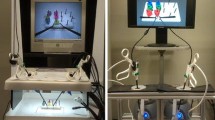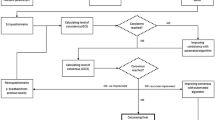Abstract
Introduction
We investigated whether the peg transfer task is interchangeable between a VR simulator and a box trainer. Our research questions: (1) Are scores of the box trainer interchangeable with the virtual equivalent of the exercise; (2) does training on the box affect performance on the VR simulator and vice versa; and (3) which system is preferred?
Methods
Experienced laparoscopists and medical interns were randomly assigned to one of two groups (V or B). They performed eight repetitions of the peg transfer task (4 on each simulator system) following a crossover study design. Group B started on the box trainer and group V started on the VR simulator. Opinion of participants was evaluated by a questionnaire.
Results
A significant correlation was found between time to complete the task on the box and the VR simulator. The comparison of the performances per system showed that group B (N = 14) performed the peg transfer task on the VR simulator in significantly less time than group V (N = 14; p = 0.014). Overall, the box was preferred over the VR simulator.
Conclusions
Although performances on the box trainer and VR simulator were correlated, they were not interchangeable. The results also imply that assessment on the VR simulator after pretraining on the box is acceptable, whereas VR simulator training alone might not suffice to pass an assessment on a box trainer. More research is needed to validate the use of the VR simulator as a FLS and PLUS assessment instrument.


Similar content being viewed by others
References
Seymour NE, Gallagher AG, Roman SA, O’Brien MK, Bansal VK, Andersen DK, Satava RM (2002) Virtual reality training improves operating room performance: results of a randomized, double-blinded study. Ann Surg 236:458
Kolkman W, van de Put MAJ, Wolterbeek R, Trimbos JBMZ, Jansen F (2008) Laparoscopic skills simulator: construct validity and establishment of performance standards for residency training. Gynecol Surg 5:109–114
Zhang A, Hünerbein M, Dai Y, Schlag PM, Beller S (2008) Construct validity testing of a laparoscopic surgery simulator (Lap Mentor). Surg Endosc 22:1440–1444
Brinkman WM, Buzink SN, Alevizos L, de Hingh IHJT, Jakimowicz JJ (2011) Criterion-based laparoscopic training reduces total training time. Surg Endosc 26:1095–1101
Fraser S, Klassen D, Feldman L, Ghitulescu G, Stanbridge D, Fried G (2003) Evaluating laparoscopic skills. Surg Endosc 17:964–967
Tjiam IM, Persoon MC, Hendrikx AJM, Muijtjens AMM, Witjes JA, Scherpbier AJJA (2012) Program for laparoscopic urologic skills: a newly developed and validated educational program. Urology 79:815–820
Tjiam IM, Schout BMA, Hendrikx AJM, Muijtjens AMM, Scherpbier AJJA, Witjes JA, Van Der Vleuten CPM (2012) Program for laparoscopic urological skills assessment: setting certification standards for residents. Minim Invasive Ther Allied Technol 22:26–32
Ritter EM, Scott DJ (2007) Design of a proficiency-based skills training curriculum for the fundamentals of laparoscopic surgery. Surg Innov 14:107–112
Peters J, Fried GM, Swanstrom LL, Soper NJ, Sillin LF, Schirmer B, Hoffman K, Committee SF (2004) Development and validation of a comprehensive program of education and assessment of the basic fundamentals of laparoscopic surgery. Surgery 135:21–27
Okrainec A, Soper NJ, Swanstrom LL, Fried GM (2011) Trends and results of the first 5 years of fundamentals of laparoscopic surgery (FLS) certification testing. Surg Endosc 25:1192–1198
Munz Y, Kumar B, Moorthy K, Bann S, Darzi A (2004) Laparoscopic virtual reality and box trainers: is one superior to the other? Surg Endosc 18:485–494
Newmark J, Dandolu V, Milner R, Grewal H, Harbison S, Hernandez E (2007) Correlating virtual reality and box trainer tasks in the assessment of laparoscopic surgical skills. Am J Obstet Gynecol 197:546. e541–546. e544
Buzink S, Soltes M, Radonak J, Fingerhut A, Hanna G, Jakimowicz J (2012) Laparoscopic surgical skills programme: preliminary evaluation of grade I level 1 courses by trainees. Wideochir Inne Tech Malo Inwazyjne 7(3):188–192
Verdaasdonk EGG, Stassen LPS, Monteny L, Dankelman J (2006) Validation of a new basic virtual reality simulator for training of basic endoscopic skills. Surg Endosc 20:511–518
Pitzul K, Grantcharov T, Okrainec A (2012) Validation of three virtual reality fundamentals of laparoscopic surgery (FLS) modules. Stud Health Technol Inform 173:349
Faul F, Erdefelder E, Lang AG, Buchner A (2007) G*Power 3: a flexible statistical power analysis program for the social, behavioral, and biomedical sciences. Behav Res Methods 39:175–191
Madan AK, Frantzides CAT, Shervin N, Tebbit CL (2003) Assessment of individual hand performance in box trainers compared to virtual reality trainers. Am Surg 69:1112–1114
Adams JA (1987) Historical review and appraisal of research on the learning, retention, and transfer of human motor skills. Psychol Bull 101:41
Taylor HL, Lintern G, Hulin CL, Talleur DA, Emanuel TW Jr, Phillips SI (1999) Transfer of training effectiveness of a personal computer aviation training device. Int J Aviat Psychol 9:319–335
Baldwin TT, Ford JK (1988) Transfer of training: a review and directions for future research. Pers Psychol 41:63–105
Chmarra MK, Dankelman J, Van Den Dobbelsteen JJ, Jansen FW (2008) Force feedback and basic laparoscopic skills. Surg Endosc 22:2140–2148
Yiasemidou M, Glassman D, Vasas P, Badiani S, Patel B (2011) Faster simulated laparoscopic cholecystectomy with haptic feedback technology. Open Access Surg 4:39–44
Madan AK, Frantzides CT, Tebbit C, Quiros RM (2005) Participants’ opinions of laparoscopic training devices after a basic laparoscopic training course. Am J Surg 189:758–761
Norman D (1998) The design of everyday things. MIT Press, Cambridge
Acknowledgments
The authors thank all participants and Tom Schakelaar, Rein H. Pas, Astrid A. Heijnen, and Kjille Schutten for their help with inclusion of participants. The authors also thank Lisette van Hulst for her editorial assistance.
Disclosures
Willem M. Brinkman, Irene M. Tjiam, and Sonja N. Buzink have no conflict of interest or financial ties to disclose.
Author information
Authors and Affiliations
Corresponding author
Rights and permissions
About this article
Cite this article
Brinkman, W.M., Tjiam, I.M. & Buzink, S.N. Assessment of basic laparoscopic skills on virtual reality simulator or box trainer. Surg Endosc 27, 3584–3590 (2013). https://doi.org/10.1007/s00464-013-2930-7
Received:
Accepted:
Published:
Issue Date:
DOI: https://doi.org/10.1007/s00464-013-2930-7




